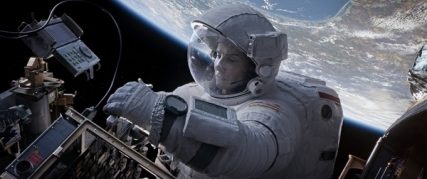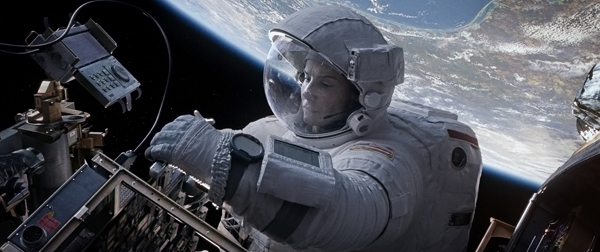
Sandra Bullock, as a scientist lost in space, struggles with faith in “Gravity.” Photo courtesy of Warner Bros. Pictures
We all know science and religion don’t meet, right? After all, the recent “Ham on Nye” duel between atheist Science Guy Bill Nye and creationist advocate Ken Ham of Answers in Genesis was a national sensation.
We all know wrong – or mostly so, says sociologist Elaine Howard Ecklund.
In the land of science, it turns out, there nearly as many believers and churchgoers as there are to be found in the nation at large and many in each camp say science and faith have a lot to offer each other.
Sunday, the Dialogue on Science, Ethics and Religion program within the American Association for the Advancement of Science (AAAS) presented a major national study examining how these two worldviews do — and often don’t — communicate.
Indeed, Ecklund said her research finds that scientists who identify as evangelical are more religious than American evangelicals who are not in science and that 48 percent of evangelicals believe science and religion can work in collaboration. And right there at the DoSER symposium, to discuss collaboration in the future, was Galen Carey, vice president for government relations for the National Association of Evangelicals (NAE), which is advising AAAS in the project.
Ecklund, director of Rice University’s Religion and Public Life Program, presented preliminary results of the study, “Religious Understandings of Science,” based on a survey of 10,000 U.S. adults including scientists, evangelical Protestants and the general public including 300 in-depth interviews with Christians (more than 140 of whom were evangelicals) Jews and Muslims.
Among the findings:
- Nearly 36 percent of scientists have no doubt about God’s existence
- 18 percent of scientists attended weekly religious services (compared with 20 percent of the general U.S. population
- 15 percent of scientists consider themselves very religious (19 percent)
- 13.5 percent of scientists read religious texts weekly (17 percent)
But research also shows where the threads of suspicion run. A 2009 study by Pew Research found a wider gap between scientists and the general public on religion. And Ecklund’s new study also found:
- 22 percent of scientists and 20 percent of the general population think most religious people are hostile to science
- 22 percent of the general population thinks scientists are hostile to religion
- 27 percent of Americans feel that science and religion are in conflict
- Of those who feel science and religion are in conflict, 52 percent sided with religion
“There is enormous stereotyping about this issue (of science in conflict with religion) and not very good information,” said Ecklund in a press release.
“The two groups don’t have to approach religion with an attitude of combat,” Ecklund said. “Rather, they should approach it with collaboration in mind.”
Carey said the NAE is preparing a resource booklet for pastors and Sunday school classes to foster thoughtful discussion between science and religion. Such discussions, he said, will be far more beneficial to both groups than the claims too often found in “direct mail pieces that say outrageous things.”
The findings in this new study dovetail with earlier research by Ecklund’ for her 2010 book. “Science vs. Religion: What Scientists Really Think.”
Back then, Ecklund surveyed 1,700 scientists and interviewed 275. She found nearly 50% identified with one of the world’s major traditions. Among the remainder, 20% still consider themselves spiritual, and many atheists and agnostics still go to church — for their spouse, their kids or the community of friends.
Ecklund told a 2010 Faith Angle conference that religious scientists rarely went public about their faith. At work, they feared a negative reaction from their colleagues. A church, they feared a negative reaction from fellow believers.
Ecklund advocated pushing the doors open, saying, “potential allies for science remain untapped within a religious American public.”
Four years later, Ecklund has bigger numbers — AAAS presented this as the largest ever study of science and religion. And there are more indications that collaboration could be possible.
But are the two camps any closer? The popular reaction to the “HamonNye” event would say no. But sham debate though it was, everyone was in the same room (or on streaming video site) watching.
Do you think debate can become conversation? Can science and religion each answer questions the other is asking about the nature of the human person?





